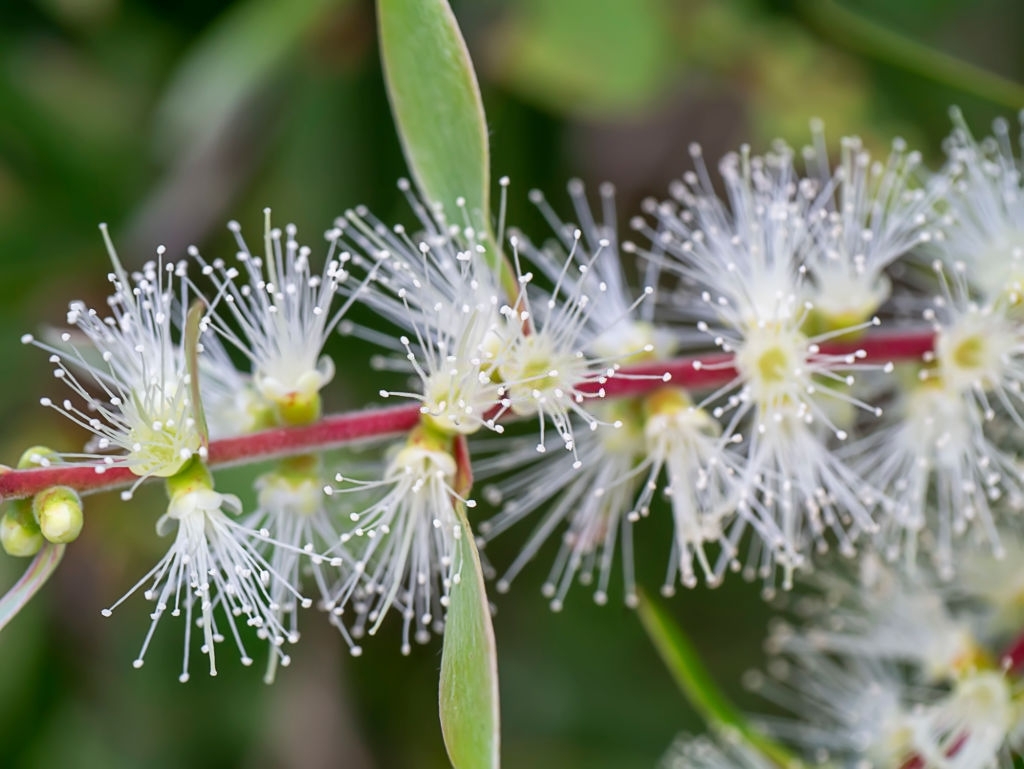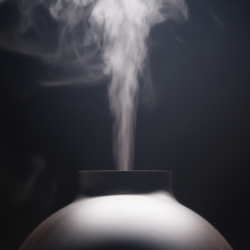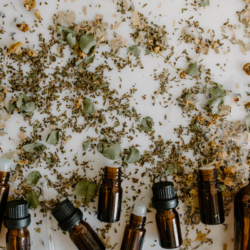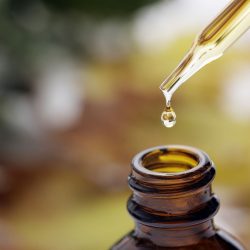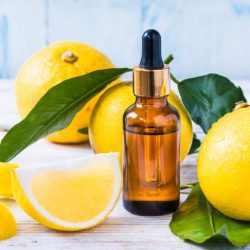Niaouli, a natural treasure with multiple virtues, is at the heart of our exploration. Botanically known as Melaleuca quinquenervia and belonging to the Myrtaceae family, this remarkable plant is distinguished by its leaves, which are veritable organs of goodness. The rich and fascinating history of Niaouli began long before it appeared in Europe in the 18th century. Traditionally used in producing countries for its febrifuge, anti-diarrhoeal and healing properties, Niaouli has followed a complex path, marked by moments of glory and oblivion, before finally establishing itself as a precious element in modern aromatherapy and pharmacopoeia.
This journey through time reveals the evolution of the use of Niaouli, from the traditional practices of the Kanaks of the Pacific to the scientific developments of the twentieth century, which highlighted its synergies with antibiotics and its applications as a generalantiseptic. Modern times have witnessed the rise and fall of Niaouli essential oil production, a story that highlights its importance in industry and medicine, as well as the growing competition with other plants such as cajeput and tea tree.
The discovery of Gomenol, a derivative of Niaouli oil, marks a turning point in the history of this plant. Initiated by Jules Prévet in New Caledonia and popularised for its therapeutic properties, this rectified essential oil has enjoyed considerable success, testifying to human ingenuity in exploiting natural resources. Finally, we explore the pharmacological properties of Niaouli leaf essential oil, highlighting its effectiveness as an expectorant, mucolytic and antimicrobial agent, characteristics that justify its continued use in contemporary medicine.
Niaouli, whose botanical name is Melaleuca quinquenervia, belongs to the Myrtaceae family. Its producing organs are its leaves.
History of Niaouli
Niaouli essential oil has long been used in producing countries as a febrifuge, antidiarrhoeal and as a vulnerable rub, but it did not appear in Europe until the 18th century. The Kanaks of the Pacific apply the leaves as a poultice to skin wounds as a healing and disinfectant agent.
In 1952,Quevauviller and Mme Panouse considered this essential oil to act in synergy with antibiotics. Valnet (20th century) considered the essential oil to be a general pulmonary, urinary and intestinal antiseptic, an antirheumatic and a vermifuge. He recommended it for chronic bronchitis, whooping cough and tuberculosis.
Modern and contemporary times
The story begins at the end of the 18th century, when French explorers collected various plants from the Myrtaceae family, including Melaleuca, which was still unknown in Europe. In 1862, De Rochas distilled Niaouli leaves for the first time.
But Niaouli was not distilled until 1862. When it was done, it was not at all successful. In fact, and more probably anecdotally, no follow-up was given to this first historically recorded attempt. In 1869, things became a little clearer: Bavay, a Navy pharmacist first class, submitted a thesis on the essential oils of niaouli and cashew. On the subject of the former, he wrote: “I do not know whether, as is supposed, niaouli oil has any future, either medical or industrial; but certainly, if this tree does not become a source of wealth for New Caledonia, this will not prevent it from having been a precious resource for its first inhabitants” Nevertheless, he adds, “I would be happy if I could draw attention to a product that I believe has some value.”
Although these words were eventually heeded, they were not immediately put into practice, as it was only 50 years after this pharmacist’s thesis that the Prévet dynasty began the real industrial production of niaouli essential oil, which grew steadily until 1939, when France went to war, production fell sharply throughout the war years, until it picked up again for a while, from around 1946 to 1950, before declining until the early 1990s, when production was very low, even lower than during the Second World War. This was partly due to competition from cajeput and then tea tree, which made life difficult for niaouli. The number of pharmaceutical formulations containing its essence fell steadily from 1975 onwards, and finally collapsed in 2003.
But what is Gomenol?
In Le Figaro on Tuesday 8 September 1896, the journalist Émile Gautier (1853-1937) wrote: “It seems that New Caledonia is home to a whole host of products that cannot be found anywhere else, not even in Australia. Among these products, to which the great Oceanian island owes the best of its originality, special mention goes to a new chemical product – let’s say a sui generis drug – which could well, if my personal ‘tips’ are to be believed, cause quite a stir in the coughing world.” This product is – as the title of this article tells us – gomenol. But what is gomenol?
Around 1887, the French industrialist Jules Prévet (1854-1940), who was in the vegetable and meat canning business, tried his hand at adventure by travelling to New Caledonia, a territory acquired by France in 1853. He was in charge of the brand new canning factory set up near the small town of Gomen (now Kaala-Gomen, 356 km north of Nouméa). He “observed that coffee picking, which was widespread in this part of the island, gave rise to wounds among the local pickers who, in order to heal themselves, chewed niaouli leaves […], then put this makeshift plaster on the wounds to prevent infection”.
Having ascertained the effectiveness of this remedy, Prévet returned to France and entrusted two scientists, Bertrand and Gueguen, with the task of studying the essence of niaouli, which they ended up attributing healing, anaesthetic and antiseptic properties to – the same properties used empirically by the natives of New Caledonia.
Marketing of Gomenol
In fact, on 2 May 1893, the trademark ” goménol ” was registered with the Paris Commercial Court, a name that Prévet explains as follows: “As it was on an estate in New Caledonia called Gomen that I began distilling this essence, and as in English-speaking countries everything that is resin or essence is referred to as gum, the idea came to me to seek a name that would Frenchify the name gum and also recall the locality where Gomenol was first produced”
What followed was the large-scale marketing ofgomenol essence and derived products, of which there are many, including balms, ointments, salves, ova, suppositories, oils, soaps, toothpastes and so on. And it’s not just a question of fairground peddling, since a great deal of scientific communication, via brochures, forms and exhibitions, is done to promote gomenol, which is in fact a rectified essential oil of niaouli: its aldehydes have been removed. It is therefore not a 100% pure and natural essential oil, as is generally required these days. But the fact remains that, therapeutically speaking, gomenol, the tree that hides the luxuriant forest of gomenol products, covers the whole of what, more or less, still justifies the use of this essential oil today, namely: gynaecological affections and those of both the urinary and respiratory tracts.
But Prévet, who was never anything more than a liberal and opportunistic industrialist, was not the “discoverer” of niaouli, just its most fervent populariser. The Melaleuca genus, to which niaouli belongs, was described by Linné in 1767, but these trees remained little known in Europe, even though French explorers harvested various extracts from plants in this botanical family, the Myrtaceae.
What are the pharmacological properties of Niaouli leaf essential oil?
Niaouli essential oil has many interesting pharmacological properties. Let’s take a look at the main ones.
Expectorant and mucolytic effect:
1,8 cineole stimulates the exocrine glands of the respiratory mucosa. In humans, it has been shown that 1,8-cineole increases the activity of the cilia in the nasal mucosa and has a bronchodilator effect. A nasal decongestant action has been obtained in humans suffering from infectious colds, but no effect in allergic rhinitis.
Expectorant, drying of respiratory mucous membranes and mucolytic, niaouli improves mucociliary clearance.
Antimicrobial effect:
The essential oil is bactericidal against Gram-positive bacteria such as Listeria monocytogenes, Staphylococcus aureus and Enterococcus sp., and Gram-negative bacteria such as Shigella flexneri, Klebsiella pneumoniae, Salmonella typhi and choleraesuis, Proteus mirabilis and Enterobacter aerogenes.
A direct antiviral effect against the herpes virus was demonstrated before the virus penetrated the cell. An antifungal effect has been demonstrated with the essential oil and citronellol.
A good ENT, respiratory, lymphoganglionic and genito-urinary anti-infective, niaouli is also an excellent antiviral with Ravintsara. Its antimicrobial activity against Gardnerella vaginalis and Candida albicans (like alpha-terpineol) is comparable to that of clotrimazole, which is useful in bacterial vaginosis.
Anti-inflammatory effect:
An anti-inflammatory action of 1,8-cineole has been demonstrated in vitro on white blood cells (monocytes) against inflammation inducers such as interleukin-1β: mediators of the inflammatory reaction such as arachidonic acid metabolites, leukotriene B, thromboxane-B and prostaglandin E are significantly reduced in the lungs, as is TNF-α (tumour necrosis factor). Clinical trials in patients with bronchial asthma have demonstrated the same properties; after treatment for 3 days with 1,8-cineole, pro-inflammatory mediators in their monocytes are reduced.
Niaouli essential oil has a cortison-like action, stimulating the pituitary-adrenal axis. It is therefore useful in the treatment of prolonged inflammatory conditions.
Its analgesic and anti-inflammatory action is due to its non-opioid effect on mast cells.
Antispasmodic effect :
1,8 cineole acts on the smooth muscles of the trachea in relation to acetylcholine.
Other effects:
- Immunomodulating
- Anti catarrhal
- Radioprotective (skin protection during radiotherapy)
- Oestrogen-like
- Venous decongestant
- Insecticide against fleas and lice
- Even more effective when combined with manuka essential oil (Leptospermum scoparium)
- Febrifuge
- Promotes skin absorption of various molecules, includingestradiol
- Gonadotropic, stimulates the pituitary-testicular and pituitary-adrenal axis
- Anti-angiogenic (leukaemic cells), inducer of apoptosis (DNA fragmentation)
Are there any precautions to be taken when using Niaouli essential oil?
- Caution in hormone-dependent pathologies; do not combine with estrogen treatment (including estroprogestogens)
- Contraindicated in pregnant or breast-feeding women
- Contraindicated in asthmatics and epileptics or in people with a history of convulsions
- Do not exceed 3 weeks’ treatment
- Do not combine with cortisone, risk of drug interaction
- Dermocaustic, revulsive action on the skin in its pure state and aggressive action on mucous membranes (redness, irritation, pruritus)
- Reserved for adults and pubescent adolescents
- Caution in cases of renal or hepatic insufficiency ( nephrotoxic and hepatotoxic)
- Enzyme inhibitor, risk of drug interactions, ask your pharmacist for advice
- Terpene derivative suppositories are contraindicated for children under 30 months of age and for those with a history of febrile convulsion or epilepsy.
- Do not disperse
Medical literature and clinical trials:
- F. Christoph, P.-M. Kaulfers, E. car Stahl-Biskup. In vitro Evaluation of the Antibacterial Activity of β-Triketones Admixed to Melaleuca Oils. Planta Med 2001
- Bakkali F, Averbeck S, Averbeck D, Idaomar M. car Biological effects of essential oils–a review. Food Chem Toxicol. 2008
- Aggarwal S, Agarwal S, Jalhan S. Essential oils as novel human skin penetration enhancer for transdermal drug delivery: a review. Int J Pharm Bio Sci 2013
- Hasani A, Pavia D, Toms N, Dilworth P, Agnew car JE. Effect of aromatics on lung mucociliary clearance in patients with chronic airways obstruction. J Altern Complement Med. 2003
- Behrbohm H, Kaschke O, Sydow K. [Effect of the phytogenic secretolytic drug Gelomyrtol forte on mucociliary clearance car of the maxillary sinus]. Laryngorhinootology. 1995
- Santos FA, Rao VS. Antiinflammatory and antinociceptive effects of 1,8-cineole a car terpenoid oxide present in many plant essential oils. Phytother Res. 2000
- Liapi C, Anifandis G, Chinou I, Kourounakis AP, Theodosopoulos S, Galanopoulou P. Antinociceptive properties of 1,8-Cineole and beta-pinene, from the essential oil of Eucalyptus camaldulensis leaves, in rodents. Planta Med. 2007
- Santos FA, Rao VS. Mast cell involvement in the rat paw oedema response to 1,8-cineole, the main constituent of eucalyptus and rosemary oils. Eur J Pharmacol. 1997
- Trinh HT, Lee IA, Hyun YJ, Kim DH. Artemisia princeps Pamp. Essential oil and its constituents car eucalyptol and α-terpineol ameliorate bacterial vaginosis and vulvovaginal candidiasis in mice by inhibiting bacterial growth and NF-κB activation. Planta Med. 2011

